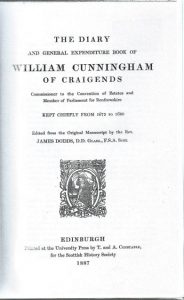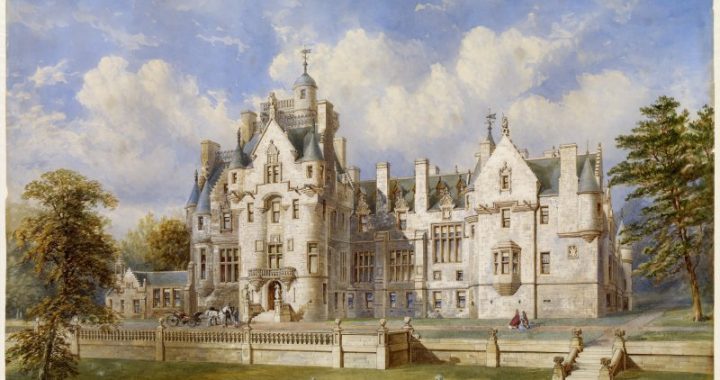 Over one hundred years before John Cuninghame, 13th Laird of Craigends kept a diary, William the 8th Laird, too, kept a diary. Unlike the 13th Laird’s very personal diary, William Cuninghame’s diary was mainly in the form of an account book of his household expenses, but it still gives an interesting insight into his life and activities.
Over one hundred years before John Cuninghame, 13th Laird of Craigends kept a diary, William the 8th Laird, too, kept a diary. Unlike the 13th Laird’s very personal diary, William Cuninghame’s diary was mainly in the form of an account book of his household expenses, but it still gives an interesting insight into his life and activities.
At the time of writing, William was heir to his father, Alexander, and was known as Master of Craigends. He married his first wife, Anne, daughter of Lord Ruthven, in April 1673. William and Anne lived in the old Craigends House with Laird Alexander and his wife. Although the couple had no children, William was trustee to Anne’s son, William, from her previous marriage to Cuninghgame of Cuninghamehead.
William’s diary is complete from November 1673 until December1680. Every item of William’s household expenditure is meticulously itemised and dated. He regularly paid his father the cost of boarding in the household. Boarding expenses ‘for horses and all’ amounted to over five hundred pounds sterling each year. William also gave money to his wife, ‘the lady’, for her expenses, and paid his own personal servants. William and Anne made regular visits to Anne’s family at Freeland in Perthshire and William, on occasion, travelled to Edinburgh to attend to legal matters on behalf of Anne’s son. The expenses incurred on these ‘voyages’ are recorded in detail, including board and lodgings, cost of servants on the journey, stabling and feed for his horses and gratuities given to servants at inns. At home, William frequently gave money to beggars and to ‘poor men at the gate’.
William was a frequent visitor in Kilbarchan village. In 1675 he appointed James King, to erect a ‘leaping-on-stone’ (used to assist in mounting a horse) close to the Parish Church. He gave regularly to the Parish Church, paid for repairs, and contributed to the parish schoolmaster’s salary. As staunch Presbyterians, the Cuninghames were opposed to the imposition of Episcopacy on the Church of Scotland. William’s diary entries include financial support given to Presbyterian ‘outed’, ministers expelled from the church for their beliefs.
Like all country lairds, William went hunting. This pursuit entailed expense for saddles, bridles and shoeing horses. His other leisure pursuits included bowling, curling, tennis and the ancient game of bullets. With the exception of tennis, which was played in Paisley, he appears to have engaged in these sports with his servants or tenants. His main expense was the money he lost in wagers, including twelve shillings ‘lost in tennice with Rossyth, in September 1675.
William dressed well and made numerous payments to tailors and shoemakers. His wardrobe included, a coat and breeches of purple cloth, fixed with ties made from fifteen ells of purple ribbon; suits adorned and fastened with silver buckles and buttons, and silver-buckled shoes. He wore a periwig and used bone and timber combs, a little pocket brush and a supply of sweet hair powder for his hair. His sword and scabbard were held in place by a belt.
William became the Laird on the death of his father in 1690. He married his second wife, Christian, the daughter of John Colquhoun of Luss, and had five children, including a daughter Lilias (b 1791). Lilias, is still celebrated in the village today in the annual historic pageant known as Lilias Day. William died in 1727 and was succeeded by his eldest son Alexander.
© 2020, Helen Calcluth

